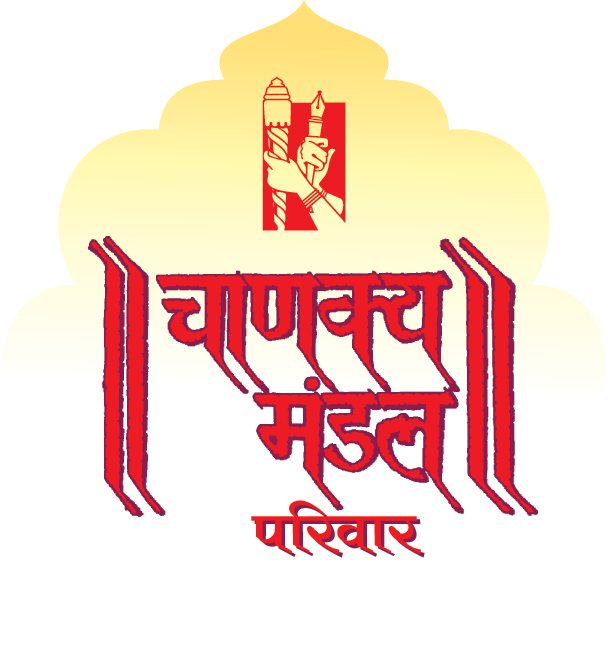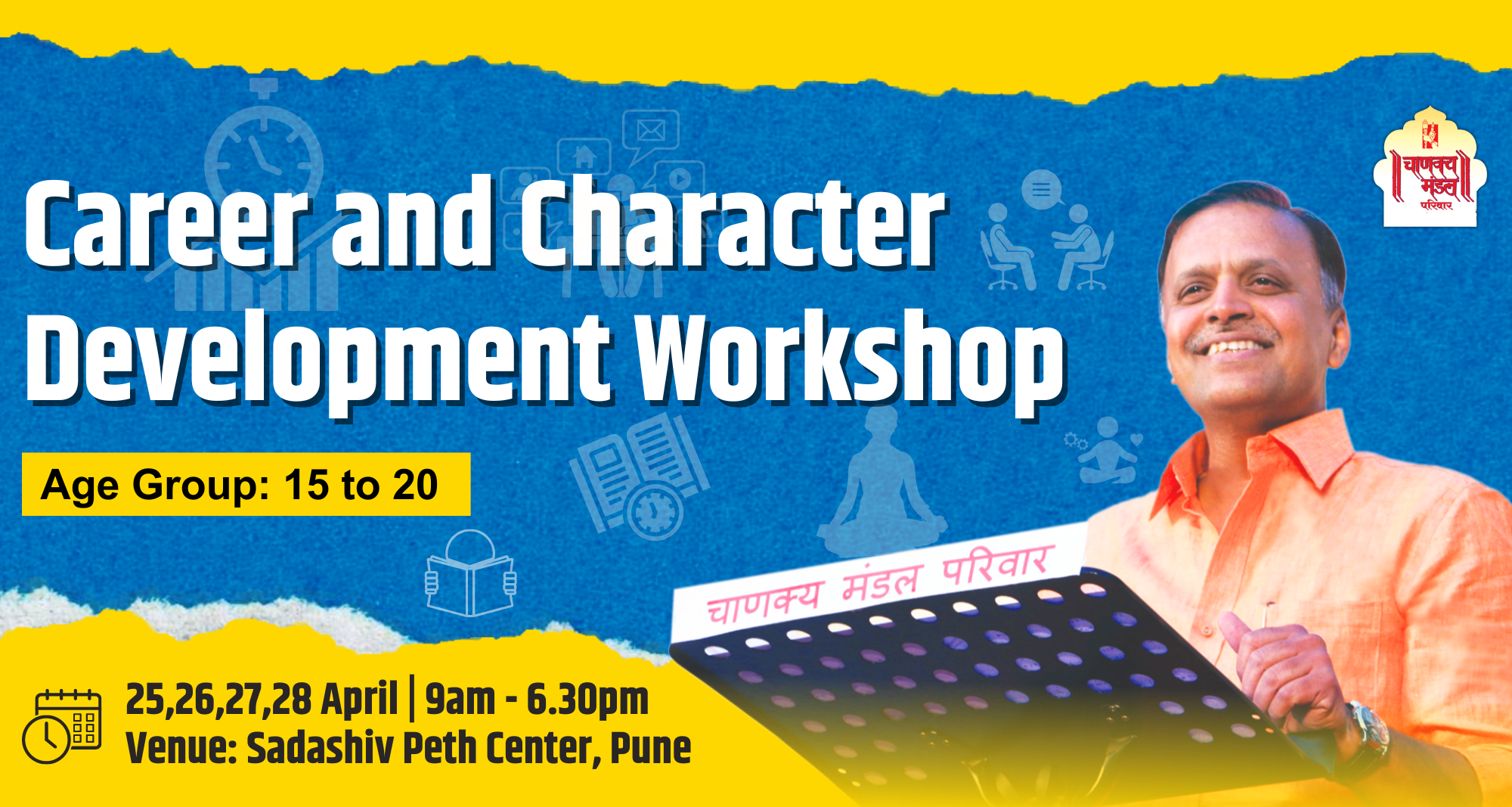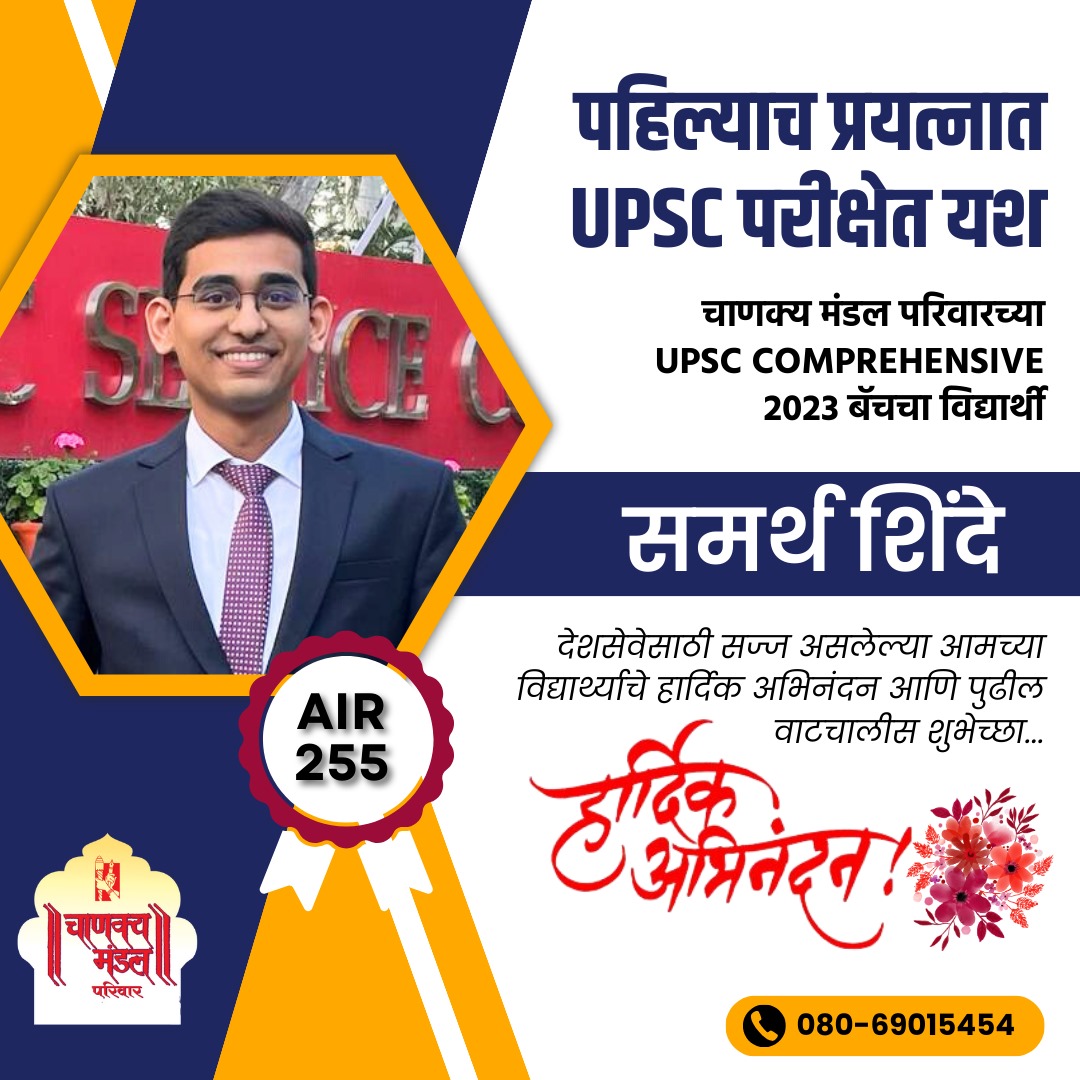Why “Chanakya”?
Arya Chanakya: Perhaps the pioneering prime bureaucrat- scholar. The thinker who realized the dangers of foreign invasion. Chanakya Mandal Pariwar has tried to awaken a corrupt exploitative, anti-people and inefficient regime. When the power-drunk corrupt regime refused to wake up, he sacrificed his career, went into wilderness organized and inspired the young generation from the commonest of the common strata of society.
He affected the political revolution which unified India and repulsed the foreign invasion. Having achieved all this he renounced all positions of power and wrote the eternal treatise ‘Artha Shastra’.
History - I Paper
खण्ड ‘A’ / Section A
1.

आपको दिए गए मानचित्र पर अंकित निम्नलिखित स्थानों की पहचान किजिए एवं अपनी प्रश्न-सह-उत्तर पुस्तिका में उनमें से प्रत्येक पर लगभग 30 शब्दों की संक्षिप्त टिप्पणी लिखिए। मानचित्र पर अंकित प्रत्येक स्थान के लिए स्थान-निर्धारण संकेत क्रमानुसार नीचे दिए गए हैं :
Identify the following places marked on the map supplied to you and write a short note of about 30 words on each of them in your Question-cum-Answer Booklet. Locational hints for each of the places marked on the map are given below seriatim :
(i) पुरापाषाणकालीन स्थल
Palaeolithic site
(ii) शवाधान-युक्त मध्यपाषाणकालीन स्थल
Mesolithic site with burials
(iii) नवपाषाणकालीन गर्तावास
Neolithic pit-dwelling
(iv) प्रारम्भिक ग्रामीण बस्ती
Early village settlement
(v) नवपाषाणकालीन स्थल
Neolithic site
(vi) नवपाषाणकालीन-ताम्रपाषाणकालीन स्थल
Neolithic-Chalcolithic site
(vii) हडप्पन युनेस्को स्थल
Harappan UNESCO site
(viii) महापाषाणकालीन शवाधान स्थल
Megalithic burial site
(ix) द्वितीय संगम का स्थल
Place of Second Ssangam
(x) प्रारम्भिक सातवाहन राजधानी
Earliest Satavahana capital
(xi) अशोक का अभिलिखित प्रतिमा स्थल
Place of inscribed statue of Ashoka
(xii) प्रथम गुप्तकालीन मुद्रा-निधी
First Gupta board of coins
(xiii) धात्विक प्रतिमा-निधी
Hoard of metal sculptures
(xiv) प्राचीन बन्दरगाह
Ancient port
(xv) प्राचीनतम जेसुइट चर्च
Oldest Jesuit Church
(xvi) गान्धार कला-केन्द्र
Centre of Gandhara art
(xvii) बौद्ध विहार
Buddhist monastery
(xviii) प्रारम्भिक विष्णु मन्दिर स्थल
Place of earliest Vishnu temple
(xix) शैव एवं बौद्ध मन्दिर संकुल
Shiva and Buddhist temple complex
(xx) प्रारम्भिक चैत्य गृह
Earliest Chaitya Griha
50
2.
(a) हडप्पीय सभ्यता का नगरीय चरित्र न तो किसी बाहरी प्रभाव का परिणाम था और न ही कोई अचानक होने वाली घटना अपितु यह स्थानीय सामाजिक-आर्थिक कारकों का क्रमिक विकास था। टिप्पणी किजिए।
The urban character of the Harappan Civilization was a result neither of any outside influence nor a sudden act but a gradual evolution of regional socio-economic factors. Comment.
(b) प्राचीन भारतीय इतिहास के स्रोत के रूप में विदेशी विवरण के कुछ लाभ हो सकते है, परन्तु इनमें कतिपय कमियाँ भी थी। उपयुक्त उदाहरणों का हवाला देते हुए इस कथन का परीक्षण किजिए।
Foreign accounts as a source of ancient Indian history may have some advantages but also have a few shortcomings. Citing appropriate examples, examine the statement.
(c) बौद्ध धर्म के कुछ विचारों की उत्पत्ती ले ही वैदीक-उपनिषदीय परम्परा में रही हो, परन्तु अपने विशिष्ट सिद्धांत और संस्थाओं के साथ यह पूर्ण रूप से एक नया धर्म था। विवेचना किजिए।
Though some of the ideas of Buddhism may have had their origin in Vedic-Upanishadic traditions but it was an altogether new religion with its own specific principles and institutions. Discuss.
15
50
3.
(a) गुप्त शासकों की आर्थिक उपलब्धियाँ एक ऐसी प्रक्रिया की परिणति थी जो कुषाण शासकों के समय शुरू हुई थी। टिप्पणी किजिए।
The economic achievements of the Guptas were the culmination of a process which began during the Kushanas. Comment.
(b) अशोक के धम्म का प्रचार-प्रसार न केवल नैतिक उत्थान और सामाजिक समरसता के लिए अपितु राज्य की शक्ती के विस्तार के लिए भी किया गया था। इस कथन का विश्लेषण किजिए।
Ashoka’s Dhamma was propagated not just for moral upliftment and social harmony but also for the extension of the state’s authority. Analyse the statement.
(c) प्रतिनिधी उदाहरणों की मदद से मन्दिर स्थापत्यकला की नागर और द्रविड शैलियों के बीच की प्रमुख भिन्नताओं का निरूपण किजिए।
With the help of representative examples, delineate the main differences between the Nagara and Dravida styles of temple architecture.
15
50
4.
(a) आठवीं तथा नौंवी शताब्दी के दौरान उत्तर भारत पर प्रभुत्व हेतु त्रिकोणीय संघर्ष के महत्त्व का मूल्यांकन किजिए।
Evaluate the importance of tripartite struggle for the domination over North India during the eighth and ninth centuries.
(b) पूर्व मध्यकाल में तमिल भक्ती आन्दोलन की प्रमुख विशेषताओं पर प्रकाश डालिए।
Throw light on the chief characteristics of Tamil Bhakti Movement during the early medieval period.
(c) कल्हण की राजतरंगिणी प्रारम्भिक भारत में इतिहास लेखन परम्परा का सर्वश्रेष्ठ उदाहरण है। विवेचना किजिए।
Kalhana’s Rajatarangini is the best example of history writing tradition in early India. Discuss.
15
50
खण्ड ‘B’ / Section B
5.
निम्नलिखित पर लगभग 150 शब्दों (प्रत्येक) में टिप्पणियां लिखिए :
Write notes on the following in about 150 words each :
(a) ‘ब्रह्मदेय’ अनुदान क्या थे ? पूर्व मध्यकाल में बडी संख्या मे दिए गए इस तरह के अनुदानों का विवरण आप कैसे देंगे ?
What were ‘Brahmadeya’ grants ? How do you account for the large number of such grants in the early medieval period ?
10
(b) तेरहवी शताब्दी के उत्तर भारत में अधिक संख्या में शहरी बस्तियों की स्थापना मुख्य रूप से तुर्की सैन्य टुकडियों की समस्त भू-भाग में तैनाती के कारण हुई थी। टिप्पणी किजिए।
The establishment of large number of urban settlements in North India in the thirteenth century was principally owing to the deployment of Turkish garrisons across the lands. Comment.
10
(c) इल्तुतमिश की मृत्यु के उपरान्त अधिकांश राजनैतिक अस्थिरता चहलगान की करतूत का परिणाम थी। स्पष्ट किजिए।
Much of the political instability after the death of Iltutmish was the doing of the Chahalgan. Elucidate.
10
(d) राजपूत चित्रकला, शैली में मुगल थी पर विषयवस्तु में राजपूत। टिप्पणी किजिए।
The Rajput school of painting was Mughal in style and Rajput in its content. Comment.
10
(e) अट्ठारहवीं शताब्दी में मराठा शक्ती के उत्थान की व्याख्या किजिए।
Account for the rise of the Maratha power in the eighteenth century.
10
50
6.
(a) अलाउद्दीन खिलजी के बाजार नियंत्रण सुलतान की सैन्य शक्ती के लिए उपयोगी थे, परन्तु सल्तनत की अर्थव्यवस्था के लिए हानिकारक। टिप्पणी किजिए।
The market regulations of Ala-ud-din Khiliji were useful for the Sultan’s military might but harmful for the economy of the Sultanate. Comment.
15
(b) अकबर के राज्यकाल में मनसबदारी व्यवस्था की प्रकृति का परीक्षण किजिए।
Examine the nature of the Mansabdari system during the reign of Akbar.
(c) चोल शासकों का सामुद्रिक विस्तार प्रमुखतया उनके विदेशी वाणिज्यिक हितों से प्रेरित था। स्पष्ट किजिए।
Chola maritime expansion was driven largely by concerns of overseas commerce. Elucidate.
20
50
7.
(a) बारहवीं शताब्दी के दक्षिणी दक्कन में वीरशैव आन्दोलन वास्तव में एक समाज सुधार का प्रयास था। विवेचना किजिए।
The Virashaiva Movement of Southern Deccan in the twelfth century was essentially an attempt at social reform. Discuss.
15
(b) हिन्दुस्तानी शास्त्रीय संगीत के विभिन्न घराने केन्द्रीय राजशाही के बजाय क्षेत्रिय रियासतों के संरक्षण के परिणाम थे। विवेचना किजिए।
The various Gharanas of Hindustani classical music were outcomes of patronage by regional princely courts, rather than central imperial ones. Discuss.
15
(c) विजयनगर राज्य और बहमनी के उत्तराधिकारी राज्यों के मध्य दीर्घकालिन संघर्ष कारणों से कम और सामरिक तथा आर्थिक कारणों से ज्यादा प्रभावित था। टिप्पणी किजिए।
The prolonged conflict between the Vijayanagara Kingdom and the Bahmani successor states was influenced less by cultural factors, and more by strategic and economic considerations. Comment.
20
50
8.
(a) मुगल काल में व्यापार एवं वाणिज्य ने भारतीय उपमहाद्विप का एकल बाजार में एकीकरण किया। टिप्पणी किजिए।
Trade and commerce in the Mughal Empire brought about the integration of the Indian subcontinent into a single market. Comment.
15
(b) औरंगजेब की दक्कन नीति मुगलों के पतन का एक प्रमुख कारण थी। विवेचना किजिए।
Aurangzeb’s Deccan policy was a major factor in Mughal decline. Discuss.
15
(c) पंद्रहवी शताब्दी की वैष्णव भक्ती परम्परा ने प्रादेशिक साहित्य के उत्कर्ष में योगदान दिया। उपयुक्त उदाहरणों के साथ विवेचना किजिए।
The Vaishnava Bhakti tradition of the fifteenth century contributed to the flourishing of provincial literature. Discuss with appropriate examples.
20
50
 CTS
CTS  Donate
Donate 



